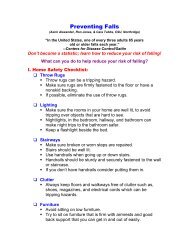Why Shoes Make “Normal” Gait Impossible - RonJones.Org
Why Shoes Make “Normal” Gait Impossible - RonJones.Org
Why Shoes Make “Normal” Gait Impossible - RonJones.Org
You also want an ePaper? Increase the reach of your titles
YUMPU automatically turns print PDFs into web optimized ePapers that Google loves.
<strong>“Normal”</strong> <strong>Gait</strong>...<br />
seventy degrees, and to fifty-five degrees<br />
on a three-inch heel. Thus, for<br />
the body to maintain an erect position,<br />
a whole series of joint adjustments<br />
(ankle, knee, hip, spine,<br />
head) are required to regain and retain<br />
the erect stance. (Fig. 1)<br />
In this reflex adjustment scores<br />
of body parts—bones, ligaments and<br />
joints, muscles and tendons—head<br />
to foot must instantly change position.<br />
If these adjustments are sustained<br />
over prolonged periods, or by<br />
habitual use of higher heels, as is<br />
not uncommon, the strains and<br />
stresses become chronic, causing or<br />
contributing to aches of legs, back<br />
and shoulders, fatigue, etc.<br />
But the alterations are internal<br />
and organic, as well. For example,<br />
when standing barefoot, the anterior<br />
angle of the female pelvis is twenty-five<br />
degrees; on low, one-inch<br />
heels it increases to thirty degrees;<br />
on two-inch heels to forty-five degrees;<br />
on three-inch heels to sixty<br />
degrees (Fig. 3). Under these conditions,<br />
what happens to the pelvic<br />
and abdominal organs? Inevitably,<br />
these must shift position to adapt.<br />
Does the wearing of low, oneinch<br />
“sensible” heels prevent these<br />
problems of postural adaptation?<br />
No. All the low heel does is lessen<br />
the intensity of the negative postural<br />
effects. Hence, the wearing of<br />
heels of any height automatically alters<br />
the natural erect state of the<br />
body column. (Note: millions of<br />
men habitually wear boots or shoes<br />
with heels one and a half to three<br />
inches in height, such as on western<br />
boots or elevator shoes.)<br />
But shoe heels have other, lesserknown<br />
influences on gait. For example,<br />
any heel, low to high, requires a<br />
compensatory alteration or forward<br />
slant on the last, which is translated<br />
to the shoe. This slant is known as<br />
the “heel wedge angle.” This is the<br />
slope or slant of the heel seat, rear<br />
to front, to compensate for the shoe<br />
heel height. The higher the heel, the<br />
greater the angle. (Figs. 4, 5)<br />
On the bare foot there is no<br />
wedge angle. The bottom of the heel<br />
is on a level one hundred and eighty<br />
degrees, with body weight shared<br />
equally between heel and ball. In-<br />
Continued on page 51<br />
Fig. 2: Forward<br />
shift of falling<br />
body weight on<br />
leg and foot<br />
from barefoot<br />
(left) to medium<br />
heel (center) to<br />
high heel (right)<br />
Fig. 3: Right, normal 30<br />
degree angle of pelvis<br />
with barefoot stance; left,<br />
on medium heel height,<br />
pelvic angle increased to<br />
45 degrees (and to 60 degrees<br />
on high heel).<br />
Fig. 6 (below): Left,<br />
barefoot, weight shared<br />
equally on heel and ball;<br />
right, on 3-inch heel<br />
weight shared 10% on<br />
heel, 90% on ball.<br />
Fig. 4: Wedge angle on medium<br />
(2-inch) heel. The higher<br />
the heel the greater the<br />
wedge angle, shifting body<br />
weight forward to the ball.<br />
Fig. 5: Effect of wedge angle on<br />
angle of foot on 2-1/2-inch heel.<br />
PODIATRY MANAGEMENT • MARCH 1999 51













